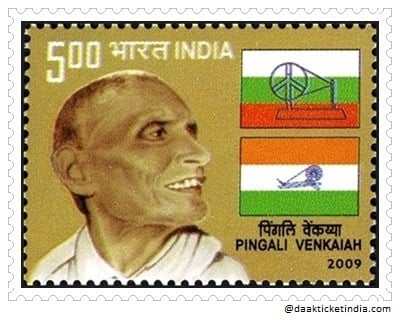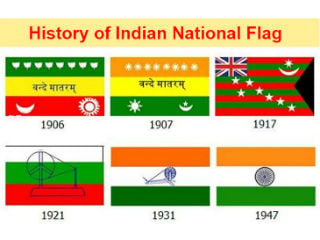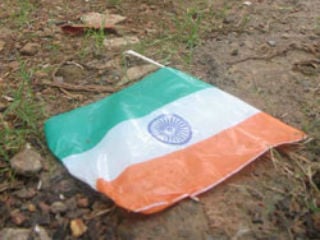Every free nation of the world has its own flag. It is a symbol of a free country. The National Flag of India was adopted in its present form during the meeting of Constituent Assembly held on the 22 July 1947, a few days before India’s independence from the British on 15 August, 1947. It served as the national flag of the Dominion of India between 15 August 1947 and 26 January 1950 and that of the Republic of India thereafter. In India, the term “tricolour” refers to the Indian national flag.
The National flag of India is a horizontal tricolor of deep saffron (kesari) at the top, white in the middle and dark green at the bottom in equal proportion. The ratio of width of the flag to its length is two to three. In the centre of the white band is a navy blue wheel which represents the chakra. Its design is that of the wheel which appears on the abacus of the Sarnath Lion Capital of Ashoka. Its diameter approximates to the width of the white band and it has 24 spokes.
Evolution of the Tricolour
It is really amazing to see the various changes that our National Flag went through since its first inception. It was discovered or recognised during our national struggle for freedom. The evolution of the Indian National Flag sailed through many vicissitudes to arrive at what it is today. In one way it reflects the political developments in the nation. Some of the historical milestones in the evolution of our National Flag involve the following:
These flags are shown here so that people know the history of India on the occasion of Independence Day and they note the diversity in various flags.
|
Flag of freedom fight – 1857 |
Flag of ‘Bhagini (Sister) Nivedita – 1905 |
|
Unofficial flag of India in 1906 The first national flag in India is said to have been hoisted on August 7, 1906, in the Parsee Bagan Square (Green Park) in Calcutta now Kolkata. The flag was composed of three horizontal strips of red, yellow and green.
|
The Berlin committee flag, first raised by Bhikaiji Cama in 1907 The second flag was hoisted in Paris by Madame Cama and her band of exiled revolutionaries in 1907 (according to some inl9OS). This was very similar to the first flag except that the top strip had only one lotus but seven stars denoting the Saptarishi. This flag was also exhibited at a socialist conference in Berlin. |
|
The flag used during the Home Rule movement in 1917 The third flag went up in 1917 when our political struggle had taken a definite turn. Dr. Annie Besant and Lokmanya Tilak hoisted it during the Home rule movement. This flag had five red and four green horizontal strips arranged alternately, with seven stars in the saptarishi configuration super-imposed on them. In the left-hand top corner (the pole end) was the Union Jack. There was also a white crescent and star in one corner. |
The flag unofficially adopted in 1921 During the session of the All India Congress Committee which met at Bezwada in 1921 (now Vijayawada) an Andhra youth prepared a flag and took it to Gandhiji. It was made up of two colours-red and green-representing the two major communities i.e. Hindus and Muslims. Gandhiji suggested the addition of a white strip to represent the remaining communities of India and the spinning wheel to symbolise progress of the Nation. |
|
The flag adopted in 1931. This flag was also the battle ensign of the Indian National Army The year 1931 was a landmark in the history of the flag. A resolution was passed adopting a tricolor flag as our national flag. This flag, the forbear of the present one, was saffron, white and green with Mahatma Gandhi’s spinning wheel at the center. It was, however, clearly stated that it bore no communal significance and was to be interpreted thus. |
Flag of Azad Hind Sena
|
 Official flag of independent India
On July 22, 1947, the Constituent Assembly adopted it as Free India National Flag. After the advent of Independence, the colours and their significance remained the same. Only the Dharma Charkha of Emperor Asoka was adopted in place of the spinning wheel as the emblem on the flag. Thus, the tricolour flag of the Congress Party eventually became the tricolour flag of Independent India.
|
Colours of the Flag
In the national flag of India the top band is of Saffron colour, indicating the strength and courage of the country. The white middle band indicates peace and truth with Dharma Chakra. The last band is green in colour shows the fertility, growth and auspiciousness of the land.
The Chakra
This Dharma Chakra depicted the “wheel of the law” in the Sarnath Lion Capital made by the 3rd-century BC Mauryan Emperor Ashoka. The chakra intends to show that there is life in movement and death in stagnation.
Designer of the Indian National Flag

Pingali Venkayya, a fervent freedom fighter and the designer of the flag on which the Indian national flag was based, was born on 2 August, 1876. He was born at Bhatlapenumarru, near Masulipatnam, in what is now the Indian state of Andhra Pradesh.
Various so-called national flags had been used by members of the Indian independence movement prior to independence being achieved in 1947. Venkayya’s version was first designed for the Indian National Congress and subsequently modified in 1947.
According to The Hindu, “Pingali Venkayya was an authority in geology, agriculture and also an educationist who set up an educational institution in Machilipatnam. He, however, died in poverty in 1963 and was largely forgotten by the society and by his own party, the Congress.” Pingali Venkayya was honoured with a postage stamp in 2009 for his contribution towards Indian freedom struggle and in 2011 it was proposed that he be posthumously awarded the Bharat Ratna.
Source : Dainik Sanatan Prabhat (Ref.: ‘Saptahik Vivek, 19th August 2012), Know India, Wikipedia










 Respect National Flag - Photo Gallery
Respect National Flag - Photo Gallery Let us unite to prevent the insult and abuse of the National Flag !
Let us unite to prevent the insult and abuse of the National Flag !